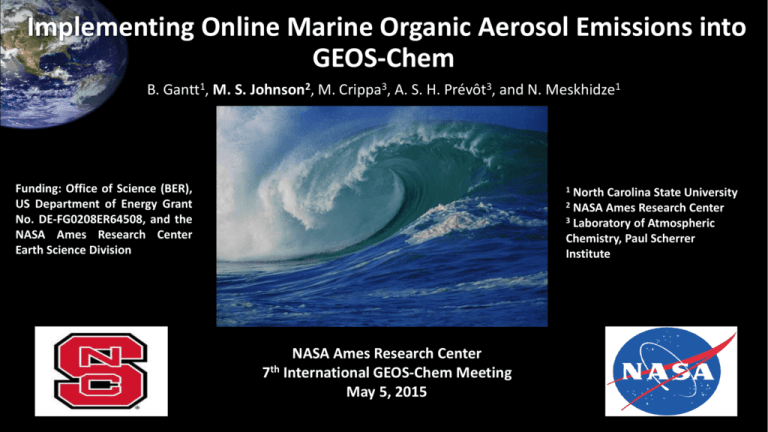TueB_CarbonAero_johnson_matthew_1_pc
advertisement

Implementing Online Marine Organic Aerosol Emissions into GEOS-Chem B. Gantt1, M. S. Johnson2, M. Crippa3, A. S. H. Prévôt3, and N. Meskhidze1 Funding: Office of Science (BER), US Department of Energy Grant No. DE-FG0208ER64508, and the NASA Ames Research Center Earth Science Division 1 North Carolina State University NASA Ames Research Center 3 Laboratory of Atmospheric Chemistry, Paul Scherrer Institute 2 NASA Ames Research Center 7th International GEOS-Chem Meeting May 5, 2015 Importance of Marine Organic Aerosols (MOA) Rinaldi et al. (2010) Need for improved climate assessments has led to increased emphasis on understanding emission sources and concentrations of natural aerosols The majority of the Earth’s surface is covered by oceans Oceanic emissions of sea salt and organic matter, in particulate form, and of sulfur, halogens, and volatile organic compounds, in gaseous form, affect the formation, number concentration, and composition of atmospheric cloud condensation nuclei (CCN) and ice nuclei (IN) Previous GEOS-Chem MOA Emission Modeling Gantt et al. (2012) Annual Average Emission Rates Using GEOS-Chem v8-01-01 Presented at the 6th Annual GC Meeting Evaluated 5 different organic sea spray emission schemes against hourly to monthly observations Global MOA emission rates ranged from 0.1 to 11.9 Tg yr -1 Gantt et al. (2012) GEOS-Chem-predicted Global MOA Emissions Applying top-down emission scheme from Gantt et al. (2012) Annual submicron MOA emissions of ~9.0 Tg was predicted for 2009 Falls within the range of previously predicted totals of MOA emissions Emissions range from < 0.1 to > 10 ng m-2 s-1 Largest emission rates in highlatitude waters during the respective spring/summer seasons Gantt et al. (2015) GEOS-Chem-predicted Global MOA Concentrations MOA surface concentrations range from < 0.1 µg m-3 to > 1.0 µg m-3 MOA concentrations are largest over regions of highest emission sources which are correlated with [chl-a] spatial distribution The fraction of total submicron OA made up by primary MOA are largest (>80%) over marine regions and decreases rapidly over terrestrial regions Gantt et al. (2015) Improved Prediction of Global Total Organic Aerosol Concentrations in Clean Marine Regions *Data is considered “clean marine” when [BC] < 50 ng m-3 and upwind fetch over the ocean With online MOA emissions Without online MOA emissions Gantt et al. (2015) GEOS-Chem without MOA emissions tends to under-predict (normalized mean bias -79%) in situ measurements and displays poor correlation (0.16) when compared to observations Model simulations with MOA emissions included in the comparison had substantially lower model bias (normalized mean bias -12%) and improved correlation (0.28) Conclusions Online emission parameterization of submicron primary MOA was implemented into the GEOS-Chem model (v9-02) This model development was designed to be used in the default setting of GEOS-Chem with the following characteristics: (1) adds minimal computational expense, (2) capable of being used for all GEOS-Chem model domains/simulation periods, and (3) treated with unique tracers for explicit atmospheric aging and tracking GEOS-Chem predicts an annual submicron MOA total of ~9.0 Tg which is comparable to past predictions Emission rates range from < 0.1 ng m-2 s-1 to > 10 ng m-2 s-1, with largest values in high-latitude oceans during the summer season Model-predicted MOA concentrations range from < 0.1 µg m-3 to > 1.0 µg m-3 and make up the majority of total submicron OA over oceanic regions Model results are comparable with existing data sets and have been extensively discussed in scientific literature; therefore proposed to be implemented in the default code Please see our publication in Geosci. Model Dev.: http://www.geosci-modeldev.net/8/619/2015/gmd-8-619-2015.pdf Additional Slides Gantt et al. (2011) Emission Parameterization Gantt et al. (2011) Atmos. Chem. Phys. Marine Primary Organic Aerosol Emission Rate (EPOA) 1 1+exp(3(−2.63[chl a])+3(0.18(U10)) 0.03 OMSSA(chl a, U10, Dp) = + 1+0.03exp(6.81Dp ) 1+exp(3(−2.63[chl a])+3(0.18(U10 )) Gantt et al. (2012) EPOA (chl a, U10 , Dp ) = 6 ×VSSA ×OMSSA ×ρSSA sea-salt emissions based on Jaeglé et al. (2011) 10m winds (U10) [chl-a] GEOS-Chem (v9-02) Model 3-D global chemical transport model (v9-02) Online sea-salt emissions Developed at Harvard University and other Power relationship with 10m winds speeds (Gong institutions around the world 2003) and 3rd order polynomial dependence on sea Full chemistry configuration surface temperature (Jaeglé et al., 2011) SMVGEAR II chemistry solver package w/ SOA Two bin sizes: fine mode (0.02 to 1.0 µm diameter) formation (Pye et al., 2010) and coarse mode (1.0 to 16.0 µm diameter) GEOS-5 meteorology Online MOA emission scheme Goddard Earth Observing System (GEOS) of Top-down emission parameterization developed the NASA Global Modeling Assimilation Office from Gantt et al. (2012) applying in situ data at Detailed emission inventories Mace Head, Ireland Fossil fuel, biomass burning, biofuel burning, Dependence on: biogenic and anthropogenic aerosols Monthly-averaged Aqua MODIS [chl-a] at 1/12° State-of-the-art transport (TPCORE) and which is spatially averaged online deposition routines GEOS-5 10m wind speeds 2⁰ x 2.5⁰ global grid resolution 2 additional tracers: 1) hydrophobic and 2) 0.5⁰ x 0.67⁰ nested regional grid resolution hydrophilic which is formed with an e-folding time 47 vertical grids of 1.15 days (identical to terrestrial OA) GEOS-Chem-predicted Nested MOA Concentrations Nested-grid simulations (0.5° x 0.67°) for July 2009 demonstrate a sharp concentration gradient over Europe Data from Paris (Crippa et al., 2013; AMSderived MOA concentrations) was used to evaluate high-resolution GEOS-Chem simulations The model demonstrates the ability to capture the temporal pattern and magnitude of observed inland MOA concentrations Correlation of 0.62 Mean bias of -120 ng m-3 Normalized mean bias of -36% Gantt et al. (2015)







